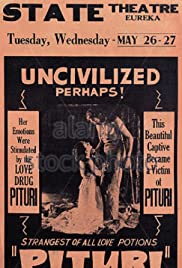
UNCIVILISED
Australia, 1936, 82 minutes, Black and white.
Dennis Hoey, Margot Rhys.
Directed by Charles Chauvel.
Uncivilised is the work of Charles Chauvel and his wife Elsa. It was based on a novel by E.V. Timms, a popular author at the time. The Chauvels had made significant films about Australian history like Heritage and were to make such films as The 40,000 Horsemen, Rats of Tobruk and, of course, Jedda.
This film, however, is rather more like a Tarzan adventure, so popular from Hollywood during the 30s. British singer and actor Dennis Hoey was brought to Australia for the central role (and two songs added to the screenplay because of this talent). The film is set in a vague Australian setting, with rather contrived Aboriginal characters, a glamorous heroine played by Margot Rhys. The film was popular enough in its time - but looks decidedly contrived from hindsight and at times, it touches on the ridiculous. However, it actually opens up insights into attitudes of Australians towards Aboriginal people during the 30s, on the eve of the 150th anniversary of the white settlement of Australia.
1. An action adventure of the '30s? The Australian flavour of the film? Its aiming at the international market, especially American? The blend of the local and the exotic? The blend of action adventure, Tarzan and operetta? A likely blend? A satisfying blend?
2. The work of Charles Chauvel? This film in his canon of features? His interest in Australian nationalism and pioneering? His being influenced by the expectations of the American market? How satisfactorily did he meet these? The importing of a British actor?
3. Black and white photography, the musical score ~ and the operatic songs? Atmosphere of Sydney in the '30s, the business world, the world of book-editing and production and the contrast with the North? The maps of the North, the coast and the smuggling-boats, the deserts and the camels, the exotic rivers and waterfalls and forests, the aboriginal camps? The corroborees? Special effects?
4. The contrived plot: the antipodean Tarzan? The novelettish aspects of his background, adventures, drug-smuggling? Credible? Escapism?
5. The world of publishers, authors? Contacts, search for exotic stories, expeditions? Responsibilities for the safety of authors etc.? The world of editing compared with that of the North?
6. The North, police, aboriginal killers, smugglers, undercover agents?
7. Beatrice and her style? Her reputation - and the rival waiting to go on the expedition and her decision? The trip and its dangers? The camel-rides in the desert? The Afghan guide? Her being abducted? The difficulties of travel, the antagonism with the Afghan? The meeting with Mara and expectations of him? Her encountering the aboriginal world? Civilisation and her makeup and composure, her inability to eat aboriginal food etc? Her learning aboriginal ways? The corroboree? Her explanation of love? The exotic touch with her swimming - and becoming 'native'? Sondra, the drug-dealers? The killer and the attack on the aboriginal camp? The truth and her realisation that she had fallen in love with Mara? The return? A novelette's intrepid heroine?
8. Mara and his credibility? His origins, missionary parents, ruling the aboriginal tribe? The rules about his white wife? Sondra and her presence in the camp, the search for the rubies? His Tarzan style of dress, activity, use of English? His bursting into song? The explanation of love? The background of Afghans, drugs, jewels? Corroborees? The battle against the aboriginal killer and his men? The happy ending? The '30s cinema hero?
9. The Afghan and his 'sliminess'? The villain, the abduction of Beatrice, his behaviour. the drugs, Sondra. the elegant drug-smuggler and the treachery, the caricature of the Afghan - and the revelation that he was the undercover agent?
10. The world of smugglers in the North: the two smugglers killed by the aborigines, the suave leader, his crew, Sondra, the murders? The arrest?
11. The Palm Island aborigines performing in the film? How much insight into the aborigines' way of life? White contact with aborigines in the 19th. century? By 1935? The aborigines and their dress. paint? Hats? Food? 'Primitive'? Religion and myths? The world of the aboriginal killer being hunted by the mounted police? Mara and his leadership of the tribe?
12. The expected resolution - satisfying for entertainment's sake? Successful popular entertainment of the '30s?